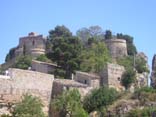
Guadalest Castle
One of the most visited locations on the Costa Blanca, Castell de Guadalest is an amazing place with a long history. Overlooked by its 12th century castle, built by the Moors in an inaccessible location atop a steep mountain, Guadalest is a picture postcard village with a resident population of just a couple of hundred. The upper town and castle can only be reached by entering a 15 metre long tunnel, carved from solid rock, and the streets below and above are lined with tiny souvenir shops selling mementos and local products. From the village square at the top there is a spectacular view of the Embalse de Guadalest reservoir, way below in the valley. The castle of Guadalest gave refuge to the Moors in their struggle for control of the area when besieged by the reconquering Christians, and held out here long after much of Spain had fallen, a picture of the castle can be seen above, showing how inaccessible this place is.